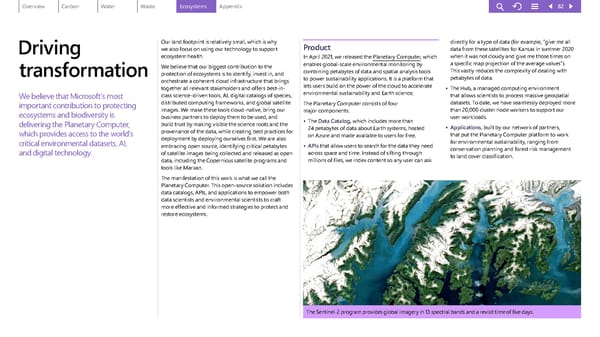Driving transforma tion We believe that Microsoft’s most important contribution to protecting ecosystems and biodiversity is delivering the Planetary Computer, which provides access to the world’s critical environmental datasets, AI, and digital technology. Our land footprint is relatively small, which is why we also focus on using our technology to support ecosystem health. We believe that our biggest contribution to the protection of ecosystems is to identify, invest in, and orchestrate a coherent cloud infrastructure that brings together all relevant stakeholders and offers best-in- class science-driven tools, AI, digital catalogs of species, distributed computing frameworks, and global satellite images. We make these tools cloud-native, bring our business partners to deploy them to be used, and build trust by making visible the science roots and the provenance of the data, while creating best practices for deployment by deploying ourselves first. We are also embracing open source, identifying critical petabytes of satellite images being collected and released as open data, including the Copernicus satellite programs and tools like Marxan. The manifestation of this work is what we call the Planetary Computer. This open-source solution includes data catalogs, APIs, and applications to empower both data scientists and environmental scientists to craft more effective and informed strategies to protect and restore ecosystems. Product In April 2021, we released the Planetary Computer , which e nables global-scale environmental monitoring by combining petabytes of data and spatial analysis tools to power sustainability applications. It is a platform that lets users build on the power of the cloud to accelerate environmental sustainability and Earth science. The Planetar y Computer consists of four major components: • The Data Catalog , which includes more than 24 petabytes of data about Earth systems, hosted on Azure and made available to users for free. • APIs that allow users to search for the data they need across space and time. Instead of sifting through millions of files, we index content so any user can ask directly f or a type of data (for example, “give me all data from these satellites for Kansas in summer 2020 when it was not cloudy and give me those times on a specific map projection of the average values”). This vastly reduces the complexity of dealing with petabytes of data. • The Hub , a managed computing environment that allows scientists to process massive geospatial datasets. To date, we have seamlessly deployed more than 20,000 cluster node workers to support our user workloads. • Applications , built by our network of partners, that put the Planetary Computer platform to work for environmental sustainability, ranging from conservation planning and forest risk management to land cover classification. The Sentinel-2 program provides global imagery in 13 spectral bands and a revisit time of five days. 82
 Environmental Sustainability Report | Microsoft Page 81 Page 83
Environmental Sustainability Report | Microsoft Page 81 Page 83